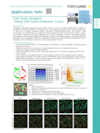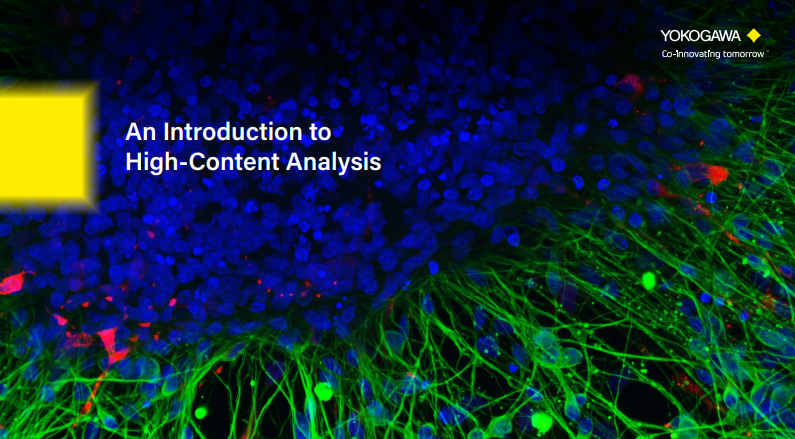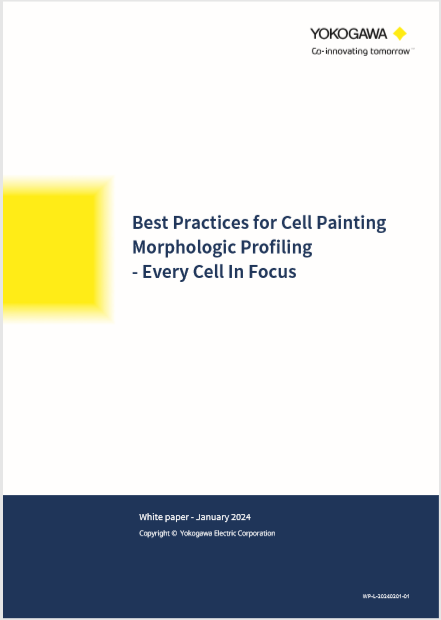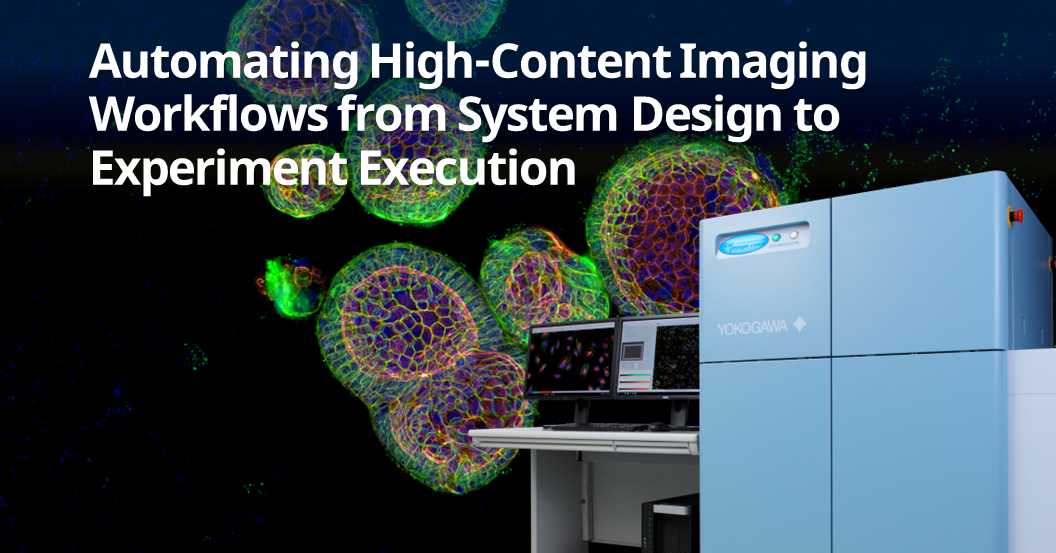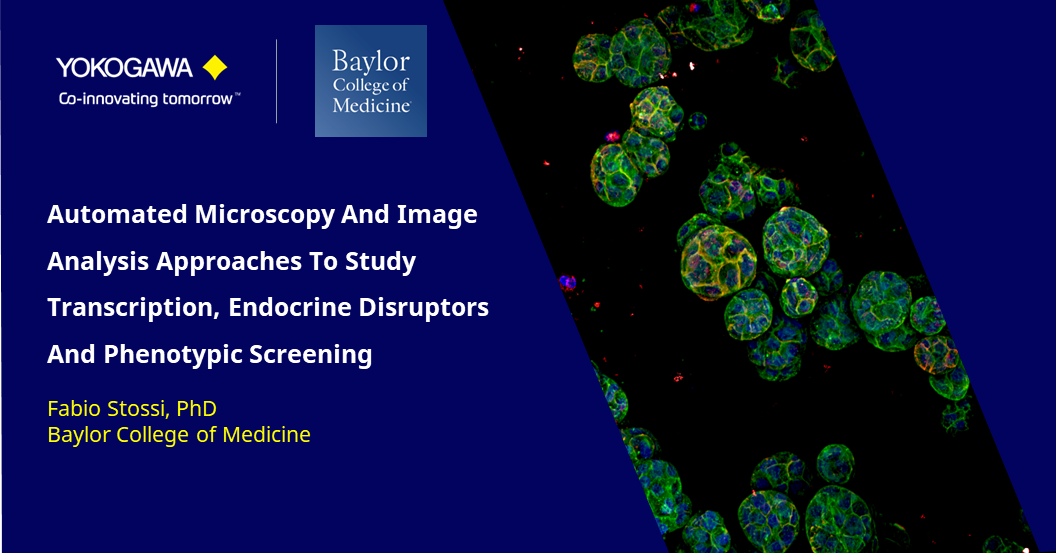Through the combination of proprietary Yokogawa high speed Confocal Scanner Technology, water immersion lenses, up to four high field-of-vision cameras, a microscopic stage with cell cultivation environment, and an integrated robotic pipetter, the unit provides high throughput, high-resolution imaging and phenotypic screening, making it the ideal choice for a variety of applications. Though known as a live-cell friendly total HCA system, the intuitive CellPathfinder software makes the CV8000 user friendly as well. Researchers can choose from a variety of templates and flexible protocol editing capabilities, use the CE bright field and machine-learning functionalities to do label-free analysis, and the new Deep Learning option largely improves cell recognition accuracy.
• Spinning Disk Technology result in higher scanning speeds and higher quality images
• Real time Confocal, label-free imaging for Live and Kinetic experiments
• High throughput increases efficiency
• Reliable, proven technology
Introduction

Within the drug development market, demands on High Content Analysis systems for drug efficacy evaluation are increasing following the need for cell-based assay and phenotypic screening. To increase screening efficiency, devices with higher speeds (higher throughput) are required.
On the other hand, to bridge the “valley of death” of the drug development process, the quality of screening hits must be increased.
This requires the construction of more complex evaluation systems that utilize multifaceted parameters via 3D cultivation systems, live-cell imaging, and higher-detail image analysis.
In current drug development research, determining how to implement throughput screening and complex evaluation system screening in parallel is an important issue.
Solution
The CellVoyager CV8000 is a high-end, High Content Analysis system that solves this contradictory screening challenge. Through the combination of a proprietary Yokogawa High-Speed Confocal Scanner, water immersion lens, up to four high field-of-vision cameras, a microscopic stage with cell cultivation environment, and an integrated robotic pipetter, we have realized not only high throughput, high-resolution imaging, but also phenotypic screening via a more complex evaluation system. In addition, our specialized analysis software, CellPathfinder, uses deep learning and machine learning to recognize target objects with high accuracy, supporting you from image analysis to results displayed using graphs.
The Yokogawa advantage
- Confocal scanner unit
- Live/kinetic experiment compatible
- High throughput
- Reliable, proven technology
Voyage to Unknown Worlds
Real-time confocal, label-free imaging
Details
State-of-the-art technology that enables you to do what you want
Observe cells as they are -Dual spinning disk confocal system-

A Yokogawa proprietary multi-scan method utilizing approximately 1,000 laser beams on the observation region and tandem disks rotating at high speed. The disks comprise a pinhole array disk with approximately 20,000 pinholes arranged in an equal pitch spiral pattern, and a microlens array disk that focuses the excitation light laser into individual pinholes. Not only does this allow high speed imaging, but it also largely prevents phototoxicity and fluorescence photobleaching.
Deeper, clearer observation -Pinhole disk exchanger-


Two different types of pinhole disks (25/50μm) can be used, according to the sample. For thick samples, reducing the pinhole diameter allows for higher confocality, shaper images. For dark samples, increasing the pinhole diameter allows for brighter images.
Organoid imaging example Upper:25μm pinhole Lower:50μm pinhole
Higher throughput screening -Optical configuration-

The optical system configuration can be selected according to the purpose. A single 96-well plate can be imaged in four colors in one minute by attaching four high- sensitivity wide -field sCMOS cameras. The system is also compatible with FRET and CellPainting assay.
Capturing finer structures -Original water immersion lens-

Water immersion lenses excel in capturing high-resolution images of cells within a liquid. The CV8000 can be equipped wit h a 40x or 60x water immersion objective lens. Our 40x lens is a particularly unique lens capable of highly advanced spherical aberration correction, allowing for the capture of bright high-resolution images over a full wide -field. The lens water supply is also completely automated. This equipment makes high throughput screening via water submersion lens possible.
Capturing live cell movement -High-precision incubator and robot pipetter-

The stage incubator features an airtight construction, managing humidity, temperature and CO2 levels. The integrated robotic pipetter conducts the following process fully automatically: tip pickup → reagent collection from the reagent plate → reagent addition to the sample plate → tip disposal. Not only can images be rapidly obtained before and after reagent instillation, but it’s also possible to add reagents to single wells multiple times, and adjust the addition speed etc., broadening the range of dynamics observation via reagent instillation.
A more live cell-friendly total HCA system
Making long-duration live-cell imaging possible -Featuring a s table built -in stage incubator-
HeLa cells were seeded in a 96 well plate at a density of 500 cells per well, and cultured for 24 hours. The well plate was then placed in the internal stage incubator and cell culturing was conducted for 72 hour s, and the total area (hereinafter Total Area) occupied by cells was analyzed. As a result, minimal unevenness in cell multiplication was observed across the 96-wells (excluding the four corner wells) when compared to a regular CO2 incubator.

Cell multiplication comparison with regular CO2 incubator after 72hr incubation(n=3)
- 96 well average: 90
- Average of outermost 36 wells: 81
- Average of 60 wells (excl. outermost): 96
The values represent the following: CV8000 Total Area after 72hrs / Total Area at 0hrs (hereinafter Total Area ratio) / CO2 incubator Total Area ratio x 100.
(Numbers near to 100 me an that cell multiplication was approximately equal for the CV8000 and CO2 incubator.)
Cell multiplication near to that of the CO2 incubator was verified, excluding the four corner wells.

Cell multiplication curves for each well of a 96-well plate
- Vertical axis: Total Area
- Horizontal axis: Time (0-72 hours)
Cell multiplication was low in the four corner wells; however, it continued in the other wells.。

Total Area ratio after cultivation start (24, 48 and 72 hours) (n=3)
Excluding the four corner wells, even after 72 hours, there were no large differences in cell multiplication.
The low variation in cell multiplication speed across the wells can 24 hours 48 hours 72 hours be seen.
More info Evaluation of cell-culture condition in CV8000’s internal stage incubator
System Integration
Centralized process management, from the cultivation environment, to transfer, imaging, analysis and data management.
We offer optimum systems in response to our customers’ needs.
High Content Analysis Software CellPathfinder
The software analyzes image data captured with the CV8000, creates graphs and exports various data. Beginner and expert users alike can take full advantage of the software, thanks to an abundance of templates and flexible protocol editing capability. CE bright field and machine-learning functionalities make label-free analysis possible. The new Deep Learning option has also been added, largely improving cell recognition accuracy.
More info High Content Analysis Software CellPathfinder

Just click the menu item for analysis
Simply follow the flow displayed at the top of the screen. The analysis menu has easy-to-understand icons. Simply click the desired menu item and the protocol will load.

Fast results for immediate verification and study
Computed numeric data can be displayed in a variety of ways. Graph plots and cell images are linked, making for easy result verification and inquiry.

Unbiased phenotype evaluation via AI
Machine-learning also provides bias-free digitization of visually-evaluated experiments. Automatic recognition is made possible simply by clicking the shape you want the software to learn.

Label-free phenotype analysis
Eliminates the time, cost and influence on cells associated with cell labelling. Even higher precision classification is made possible through combination with deep learning.
Specifications
High-throughput Cytological Discovery System
| Model | CV8000 |
|---|---|
| Sample format | Multiple well plate (6, 12, 24, 48, 96, 384, 1536 wells), glass slide |
| Image mode | Confocal mode: max. 4 color simultaneous recording Bright field/phase contrast (10x, 20x for 6, 12, 24 well plates), digital phase contrast (10x, 20x) |
| Output data format | Image data: 16bit TIFF, PNG umerical data: CSV, original format |
| Excitation wavelength | 405/445/488/561/640 nm, all solid laser, max. 5 lasers 【Option】365 nm LED |
| White light illumination | LED |
| Autofocus | Laser-based mode, image-based mode |
| Objectives | Max. 6 lenses are available, automatically switchable Dry: 2x, 4x, 10x, 20x, 40x Water immersion: 20x, 40x, 60x hase contrast: 10x, 20x Long working distance: 20x |
| Confocal unit | Microlens-enhanced wide-view dual Nipkow disk confocal scanner, 50 μm pinhole 【Option】 25 μm pinhole disk and auto pinhole disk exchanger |
| Camera | sCMOS (effective pixels: 2000X2000 pixel size: 6.5 μm), max. 4 cameras |
| Stage incubator | Temperature for incubation : 35-40℃ CO2 supply box (CO2: 5%, forced humidification) |
|
Robot pipetter |
【Option】 Disposable tip type (96tip or 384tip type) |
| Bar code reader | 【Option】 1 or 2 dimension |
| Workstations | Dual-monitor work station for system control, dual-monitor work station for data analysis |
| Analysis software | High Content Analysis Software CellPathfinder Granularity, Neurite, Nuclear morphology, Nuclear translocation, Plasma membrane translocation, Machine learning, Label-free analysis, 3D analysis, Deep Learning, etc. |
| Operating environment | 15~30℃ 30~70%RH (no condensation) |
| Power supply | Measurement unit:AC100-240V, 50/60Hz, 2KVA max Workstation for system control:AC100-240V, 50/60Hz, 1.3KVA max Workstation for data analysis:AC100-240V, 50/60Hz, 950VA max |
| Dimensions | Measurement unit: W1,280×D895×H1,450 mm |
| Weight | Measurement unit: 510Kg |

CV8000 Partner
Asia

Shanghai Genesci Medical technology Co.,Ltd.
People's Republic of China (excluding Hong Kong, Taiwan, Macao)
Oceania

TrendBio 
Australia, New Zealand
-
CellLibrarian
CellLibrarian is a powerful solution to manage a volume of image data acquired by Yokogawa CellVoyager series.
Resources
single-cell analysis specifically transcription by steroid receptors primarily estrogen and androgen receptors
drug discovery and drug development for an interrelated set of disorders that emanate from type II diabetes and obesity
The CV8000 nuclear translocation analysis software enables the analysis of changes in the localization of signal molecules that transfer between cytoplasm and nuclei, such as proteins. The following is an example of the translocation analysis of NFκB, a transcription factor.
With 462 million affected individuals, diabetes and associated conditions consume about 12% of global health expenditure. Current treatments lack focus on the root cause—the loss of pancreatic insulin-producing beta-cells. This Michigan research team developed a robust, intact ex vivo pancreatic islet bioassay capable of detecting diabetes-relevant endpoints including beta-cell proliferation, chemoprotection, and islet spatial morphometrics.
Fluorescent ubiquitination-based cell cycle indicator (Fucci) is a set of fluorescent probes which enables the visualization of cell cycle progression in living cells.
Yokogawa collaborates with scientists in the medical and pharmacology fields to identify best practices for cell painting and high-content screening, thereby enhancing image analysis and reproducibility.
High-content screening is a crucial technique in drug development, utilized both in the initial phases for identifying new candidate compounds and in later phases for assessing the pharmacological effects and safety of these candidates. This report highlights three applications using Yokogawa’s CellVoyager CV8000 and CQ1 high-content screening systems, paired with Yokogawa’s CellPathfinder analysis software, creating an integrated and user-friendly platform for drug discovery.
Featured Assays
- Hepatotoxicity Assay: Evaluating the effect of vitamin K on HepG2 cells.
- Cell Migration Assay: Investigating the impact of mitomycin C on cell migration.
- In Vivo Tumor Metastasis: Studying tumor metastasis using zebrafish models.
List of Selected Publications for High-Content Screening Systems: CV8000, CV7000, CV6000
Downloads
Brochures
Videos
The CV8000 features a cell incubator with an improved airtight design that facilitates the observation of cell behavior over long periods of time. In addition, the CV8000 comes with CellPathfinder, a new program that can analyze images of unlabeled cells and 3D images of samples. With these features, the CV8000 improves the efficiency of drug discovery research and biomedical research on leading-edge subjects such as iPS and ES cells.
In this webinar, Professor Jonny Sexton discusses a pipeline, developed in the Sexton lab, for the quantitative high-throughput image-based screening of SARS-CoV-2 infection to identify potential antiviral mechanisms and allow selection of appropriate drug combinations to treat COVID-19. This webinar presents evidence that morphological profiling can robustly identify new potential therapeutics against SARS-CoV-2 infection as well as drugs that potentially worsen COVID-19 outcomes.
Human pluripotent stem cells are proven efficient models for drug screening campaigns. They provide access to unlimited starting material amenable to high throughput small molecule compound screening. Due to their capacity to generate mode complex cellular models, they also offer the potential to perform high content screening in tissue-specific organoids for further human target validation.
Dr. Alejandro Hidalgo-Gonzalez at MCRI(Murdoch Children's Research Institute) in Australia is a user of our HCA system CellVoyager CV8000 and he has established a pipeline for assay development and automated unbiased phenotypic drug screening using human pluripotent stem cell-derived cells and organoids. This is a recording of his presentation at an educational webinar organized by A*STAR in Singapore.
Are you looking to improve laboratory workflows, data management, and imaging analysis?
This webinar covers the integration of a high-content imager into a modern laboratory automation system and workflows built to utilize it. This on-demand webinar describes the integration topology used in the High Throughput Bioscience Center at St. Jude and the technical challenges that emerged pertaining to data handling and analysis. The webinar addresses the variety of ways we have used our high-content imager in the context of a high throughput screening center, using examples of experiment workflows from recent users.
Key Topics:
- Body Copy:
- Key considerations for integrating a high-content imager into a laboratory robot system
- Methods for interfacing between robots and the imager
- Important considerations for imaging data management and analysis
- How the St. Jude High Throughput Bioscience Center supports the diverse imaging needs of its projects
Visualizing the complex spatiotemporal dynamics of human stem cells as they proliferate and make cell fate decisions is key to improving our understanding of how to robustly engineer differentiated tissues for therapeutic applications.
In this webinar, Dr. Rafael Carazo Salas will describe multicolor, multiday high-content microscopy pipelines that his group has recently developed to visualize the dynamical cell fate changes of human Pluripotent Stem Cells (hPSCs).
Key Topics:
- Visualizing how human Pluripotent Stem Cells (hPSCs) proliferate and undergo early differentiation in vitro, by high content microscopy
- Learning about experimental and computational pipelines that enable monitoring single-cell fate dynamics
- Learning about novel “live” reporters of hPSC cell fate
Speaker
Rafael Carazo Salas, PhD
Professor, School of Cellular and Molecular Medicine
University of Bristol
This webinar highlights Yokogawa’s High Content Solutions, the benchtop confocal CellVoyager CQ1, and CellVoyager CV8000. Utilizing Yokogawa’s dual-wide microlens spinning disk confocal technology, these automated HCA systems provide remarkable image quality while increasing your output. This frees up time to complete other research activities. Also, recent additions to the CSU-W1 confocal upgrade is discussed. The SoRa, a super-resolution solution, and the Uniformizer, an image flattening device. Both of which can be added to the lightpath of your CSU-W1-enhanced microscope.
Agenda:
Introduction to Yokogawa
SoRa for CSU-W1 super-resolution with confocal
Two high content instruments from Yokogawa: The CQ1 and the CV8000
Presenter:
Dan J. Collins, Applications Scientist, Yokogawa Life Science
News
-
Press Release | Corporate Dec 3, 2020 Yokogawa and InSphero Enter into Partnership Agreement
- Supporting drug development research through the use of HCA and three-dimensional culture models -
-
Press Release | Solutions & Products Sep 5, 2017 Yokogawa Releases CellVoyager CV8000 High-throughput Cytological Discovery System
- For the faster discovery of new drugs and improved efficiency in biomedical research -
Looking for more information on our people, technology and solutions?
Contact Us













